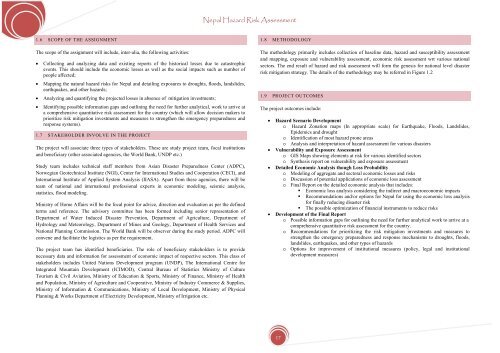Nepal Hazard Risk Assessment - Asia-Pacific Gateway for Disaster ...
Nepal Hazard Risk Assessment - Asia-Pacific Gateway for Disaster ...
Nepal Hazard Risk Assessment - Asia-Pacific Gateway for Disaster ...
You also want an ePaper? Increase the reach of your titles
YUMPU automatically turns print PDFs into web optimized ePapers that Google loves.
<strong>Nepal</strong> <strong>Hazard</strong> <strong>Risk</strong> <strong>Assessment</strong><br />
1.6 SCOPE OF THE ASSIGNMENT<br />
The scope of the assignment will include, inter-alia, the following activities:<br />
• Collecting and analyzing data and existing reports of the historical losses due to catastrophic<br />
events. This should include the economic losses as well as the social impacts such as number of<br />
people affected;<br />
• Mapping the natural hazard risks <strong>for</strong> <strong>Nepal</strong> and detailing exposures to droughts, floods, landslides,<br />
earthquakes, and other hazards;<br />
• Analyzing and quantifying the projected losses in absence of mitigation investments;<br />
• Identifying possible in<strong>for</strong>mation gaps and outlining the need <strong>for</strong> further analytical, work to arrive at<br />
a comprehensive quantitative risk assessment <strong>for</strong> the country (which will allow decision makers to<br />
prioritize risk mitigation investments and measures to strengthen the emergency preparedness and<br />
response systems).<br />
1.7 STAKEHOLDER INVOLVE IN THE PROJECT<br />
The project will associate three types of stakeholders. These are study project team, focal institutions<br />
and beneficiary (other associated agencies, the World Bank, UNDP etc.)<br />
Study team includes technical staff members from <strong>Asia</strong>n <strong>Disaster</strong> Preparedness Center (ADPC),<br />
Norwegian Geotechnical Institute (NGI), Center <strong>for</strong> International Studies and Cooperation (CECI), and<br />
International Institute of Applied System Analysis (IIASA). Apart from these agencies, there will be<br />
team of national and international professional experts in economic modeling, seismic analysis,<br />
statistics, flood modeling.<br />
Ministry of Home Affairs will be the focal point <strong>for</strong> advice, direction and evaluation as per the defined<br />
terms and reference. The advisory committee has been <strong>for</strong>med including senior representation of<br />
Department of Water Induced <strong>Disaster</strong> Prevention, Department of Agriculture, Department of<br />
Hydrology and Meteorology, Department of Mines and Geology, Department of Health Services and<br />
National Planning Commission. The World Bank will be observer during the study period. ADPC will<br />
convene and facilitate the logistics as per the requirement.<br />
The project team has identified beneficiaries. The role of beneficiary stakeholders is to provide<br />
necessary data and in<strong>for</strong>mation <strong>for</strong> assessment of economic impact of respective sectors. This class of<br />
stakeholders includes United Nations Development program (UNDP), The International Centre <strong>for</strong><br />
Integrated Mountain Development (ICIMOD), Central Bureau of Statistics Ministry of Culture<br />
Tourism & Civil Aviation, Ministry of Education & Sports, Ministry of Finance, Ministry of Health<br />
and Population, Ministry of Agriculture and Cooperative, Ministry of Industry Commerce & Supplies,<br />
Ministry of In<strong>for</strong>mation & Communications, Ministry of Local Development, Ministry of Physical<br />
Planning & Works Department of Electricity Development, Ministry of Irrigation etc.<br />
1.8 METHODOLOGY<br />
The methodology primarily includes collection of baseline data, hazard and susceptibility assessment<br />
and mapping, exposure and vulnerability assessment, economic risk assessment wrt various national<br />
sectors. The end result of hazard and risk assessment will <strong>for</strong>m the genesis <strong>for</strong> national level disaster<br />
risk mitigation strategy. The details of the methodology may be referred in Figure 1.2<br />
1.9 PROJECT OUTCOMES<br />
The project outcomes include:<br />
• <strong>Hazard</strong> Scenario Development<br />
o <strong>Hazard</strong> Zonation maps (In appropriate scale) <strong>for</strong> Earthquake, Floods, Landslides,<br />
Epidemics and drought<br />
o Identification of most hazard prone areas<br />
o Analysis and interpretation of hazard assessment <strong>for</strong> various disasters<br />
• Vulnerability and Exposure <strong>Assessment</strong><br />
o GIS Maps showing elements at risk <strong>for</strong> various identified sectors<br />
o Synthesis report on vulnerability and exposure assessment<br />
• Detailed Economic Analysis though Loss Probability<br />
o Modeling of aggregate and sectoral economic losses and risks<br />
o Discussion of potential applications of economic loss assessment<br />
o Final Report on the detailed economic analysis that includes:<br />
• Economic loss analysis considering the indirect and macroeconomic impacts<br />
• Recommendations and/or options <strong>for</strong> <strong>Nepal</strong> <strong>for</strong> using the economic loss analysis<br />
<strong>for</strong> finally reducing disaster risk<br />
• The possible optimization of financial instruments to reduce risks<br />
• Development of the Final Report<br />
o Possible in<strong>for</strong>mation gaps <strong>for</strong> outlining the need <strong>for</strong> further analytical work to arrive at a<br />
comprehensive quantitative risk assessment <strong>for</strong> the country.<br />
o Recommendations <strong>for</strong> prioritizing the risk mitigation investments and measures to<br />
strengthen the emergency preparedness and response mechanisms to droughts, floods,<br />
landslides, earthquakes, and other types of hazards<br />
o Options <strong>for</strong> improvement of institutional measures (policy, legal and institutional<br />
development measures)<br />
17
















